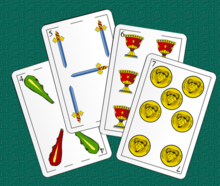
Back رموز أوراق اللعب Arabic Coll (cartes) Catalan Barva (karty) Czech Kulør (kortspil) Danish Farbe (Kartenspiel) German Palo (naipes) Spanish خال ورق Persian Pelikorttien maat Finnish Enseigne (carte à jouer) French Klöören (spelkoorden) FRR


In playing cards, a suit is one of the categories into which the cards of a deck are divided. Most often, each card bears one of several pips (symbols) showing to which suit it belongs; the suit may alternatively or additionally be indicated by the color printed on the card. The rank for each card is determined by the number of pips on it, except on face cards. Ranking indicates which cards within a suit are better, higher or more valuable than others, whereas there is no order between the suits unless defined in the rules of a specific card game. In most decks, there is exactly one card of any given rank in any given suit. A deck may include special cards that belong to no suit, often called jokers.
While English-speaking countries traditionally use cards with the French suits of Clubs, Spades, Hearts and Diamonds, many other countries have their own traditional suits. Much of central Europe uses German suited cards with suits of Acorns, Leaves, Hearts and Bells; Spain and parts of Italy and South America use Spanish suited cards with their suits of Swords, Batons, Cups and Coins; German Switzerland uses Swiss suited cards with Acorns, Shields, yellow Roses and Bells; and many parts of Italy use Italian suited cards which have the same suits but different patterns compared with Spanish suited cards. Asian countries such as China and Japan also have their own traditional suits. Tarot card packs have a set of distinct picture cards alongside the traditional four suits.